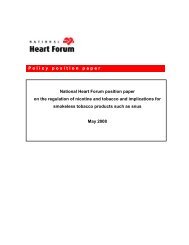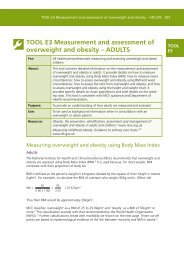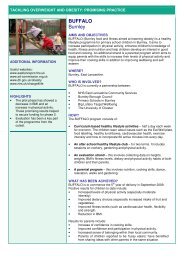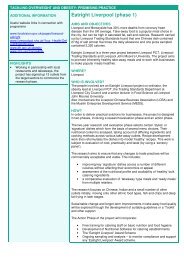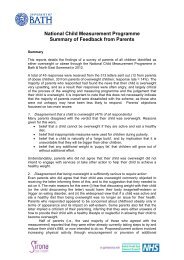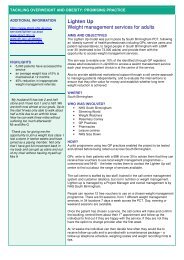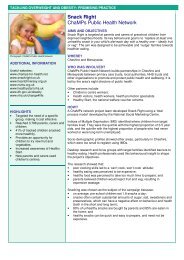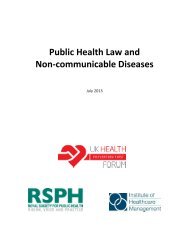The Challenge of Non-Communicable Diseases and Road Traffic ...
The Challenge of Non-Communicable Diseases and Road Traffic ...
The Challenge of Non-Communicable Diseases and Road Traffic ...
You also want an ePaper? Increase the reach of your titles
YUMPU automatically turns print PDFs into web optimized ePapers that Google loves.
An Overview 55<br />
to fragmentation <strong>and</strong>/or duplication in distribution<br />
functions [388].<br />
Medicines may be <strong>of</strong> poor quality <strong>and</strong> the number<br />
<strong>of</strong> cases <strong>of</strong> counterfeit medicines is increasing.<br />
<strong>Challenge</strong>s also exist around the promotion <strong>of</strong> rational<br />
use <strong>of</strong> medicines: given the long-term market<br />
potential <strong>of</strong> drugs for ‘chronic diseases’, the pharmaceutical<br />
industry can be actively engaged in the<br />
development <strong>of</strong> clinical guidelines which can lead to<br />
potential conflicts <strong>of</strong> interest [389].<br />
Responses<br />
Equitable access to essential medicines, vaccines,<br />
<strong>and</strong> technologies, their assured quality <strong>and</strong> safety,<br />
<strong>and</strong> their effective use by prescribers <strong>and</strong> consumers<br />
are important goals [373]. For some NCDs, as<br />
for AIDS, prevention may be aided by treatment: it<br />
is estimated that appropriate use <strong>of</strong> medicines alone<br />
could reduce the burden <strong>of</strong> NCDs by up to 80 percent<br />
[388]. Many patients will require long-term, if<br />
not life-long, access to medicines as well as other<br />
equipment; living with Type 1 diabetes mellitus for<br />
example requires not just insulin but also syringes,<br />
needles, <strong>and</strong> diagnostic <strong>and</strong> monitoring tools [390].<br />
Both price- <strong>and</strong> non-price barriers to access need<br />
to be overcome. Improving purchasing efficiency,<br />
eliminating taxes, <strong>and</strong> regulating mark-ups could<br />
reduce medicine prices; <strong>and</strong> more efficient procurement<br />
<strong>and</strong> distribution <strong>of</strong> medicines would increase<br />
access [385]. Guidelines for good pharmaceutical<br />
procurement have been published <strong>and</strong> capacity<br />
building <strong>and</strong> information exchange could improve<br />
essential procurement <strong>and</strong> regulatory capacities in<br />
many countries [391].<br />
Countries could save an estimated 60 percent <strong>of</strong><br />
their pharmaceutical expenditures if they shifted<br />
from originator medicines to generic products, but<br />
only a few wealthy <strong>and</strong> middle-income countries do<br />
so [371]. Most first-line drugs for the treatment <strong>of</strong><br />
NCDs are <strong>of</strong>f-patent <strong>and</strong> inexpensive: even for cancer,<br />
many medicines are <strong>of</strong>f-patent generics, costing<br />
less than US$100 per treatment course [214]. Generic<br />
products could be promoted through patient<br />
<strong>and</strong> pr<strong>of</strong>essional education, alongside technology<br />
assessment <strong>and</strong> evidence-based guidelines which<br />
are enforced <strong>and</strong> adapted to the local situation.<br />
National Essential Medicines Lists need to include<br />
drugs for NCDs chosen by national experts based on<br />
considerations <strong>of</strong> cost-effectiveness, budget impact,<br />
affordability, <strong>and</strong> so forth.<br />
Lessons might be learnt from the scale-up <strong>of</strong> ART<br />
where transparency in price information, generic<br />
competition, <strong>and</strong> price negotiation helped achieve<br />
dramatic decreases in price; some steps have already<br />
been applied in Brazil to reduce the cost <strong>of</strong> certain<br />
cancer medicines [392]. A GAVI-like capacity at regional<br />
or global level could be useful to negotiate,<br />
bulk purchase, <strong>and</strong> distribute vaccines <strong>and</strong> drugs.<br />
Mechanisms such as Advance Market Commitments,<br />
as used for vaccines [393], could be considered<br />
to <strong>of</strong>fer an improved market for drugs now in<br />
development, ensuring that drugs are bought only if<br />
they meet pre-determined st<strong>and</strong>ards <strong>of</strong> efficacy <strong>and</strong><br />
safety <strong>and</strong> helping to assure a sustained <strong>and</strong> affordable<br />
supply in the long term.<br />
<strong>The</strong>re are emerging concerns regarding intellectual<br />
property rights in relation to NCD drugs,<br />
particularly for cancer <strong>and</strong> diabetes, <strong>and</strong> how these<br />
might interfere with innovation models <strong>and</strong> access<br />
to treatments [394]. Since the WTO TRIPS<br />
(trade-related aspects <strong>of</strong> intellectual property rights)<br />
agreement, health <strong>of</strong>ficials need a good underst<strong>and</strong>ing<br />
<strong>of</strong> patent status in order to procure lower-cost<br />
generic products, use health budgets efficiently, <strong>and</strong><br />
determine the ‘freedom to operate’ in research <strong>and</strong><br />
development <strong>of</strong> new medicines; this may require national<br />
<strong>and</strong> regional capacity to be built.<br />
An additional area requiring joint commitment<br />
<strong>and</strong> resources to strengthen the overall response to<br />
NCDs, involves the need for improving governance<br />
<strong>and</strong> regulation in the pharmaceutical sector, building<br />
upon ongoing efforts as noted in Box 9.<br />
Health-Care Delivery<br />
Health service delivery systems in LMIC are typically<br />
more suited to providing episodic care for<br />
acute conditions. Models for the delivery <strong>of</strong> care for<br />
chronic conditions, such as integration <strong>of</strong> care across<br />
levels, may be unfamiliar to policymakers <strong>and</strong> practitioners,<br />
<strong>and</strong> their establishment hindered by limitations<br />
<strong>of</strong> space, staff, systems, <strong>and</strong> infrastructure<br />
[211, 396]. To some extent, HIV/AIDS may have



